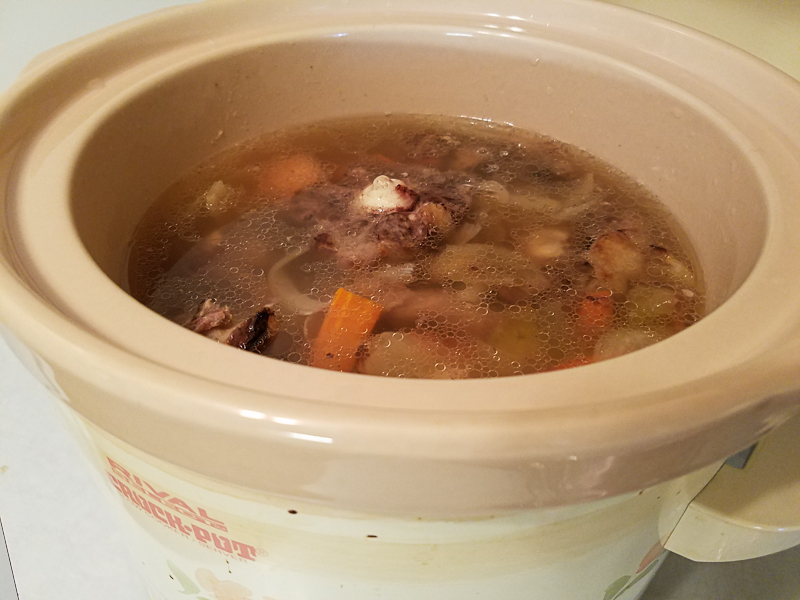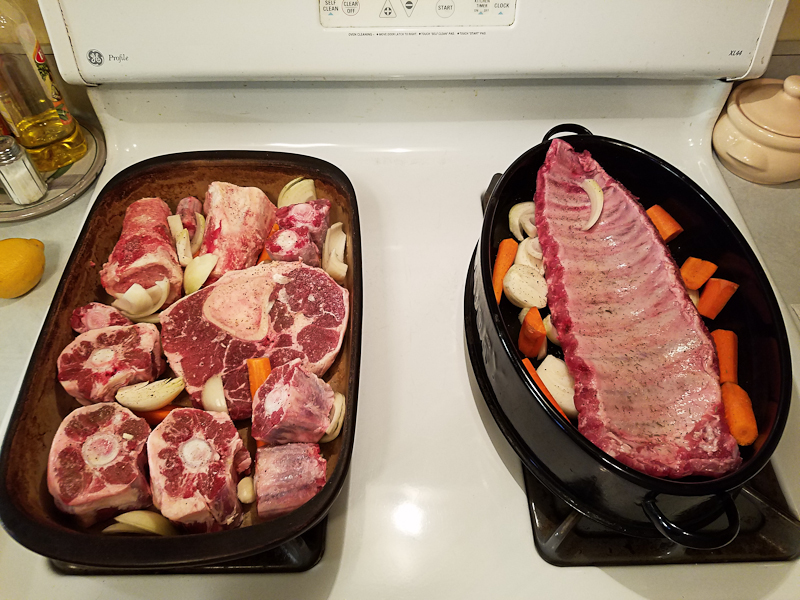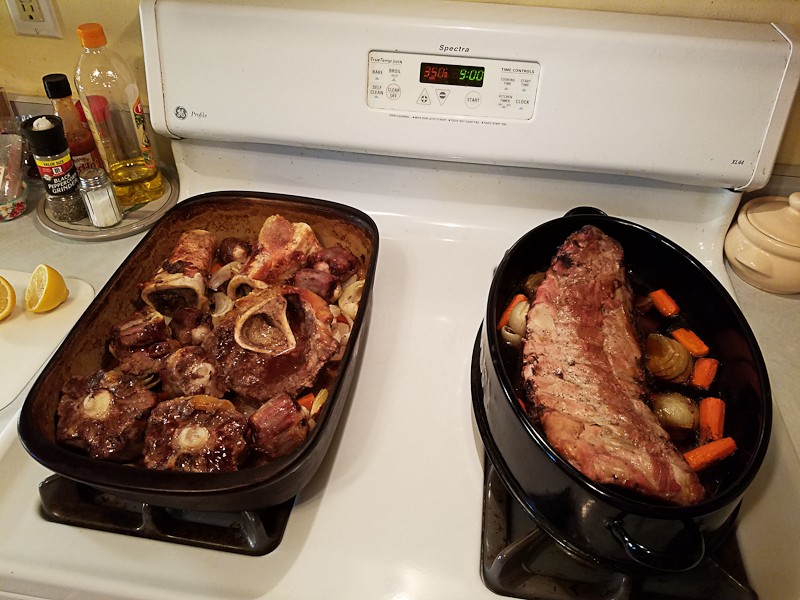Soup, with Love
February 10, 2019
"A soup like this is not the work of one man. It is the result of a constantly refined tradition. There are nearly a thousand years of history in this soup." - Willa Cather

Beef Broth
Restoring bone damaged by infection by using bone-broth soup
Dental Implant Fail
On Monday, November 19, 2018, my husband, Don, endured seven hours of dental surgery as his remaining lower teeth were extracted, and five implants were put in place. Two days later, the day before Thanksgiving, his dentist, Joyce, installed the lower dental fixture by bolting it to the implants, and we thought we were done.
Unfortunately, although he was taking antibiotics, Don developed an infection over the Thanksgiving weekend. Don ended up having a total of three infections over the next few weeks. Each time required additional dental surgery to clean it up, followed by more sutures, more antibiotics that made him throw up, and more pain killers that didn't work. It was a nightmare that dragged on for weeks, through the entire holiday season.
Emergency Surgery
Finally, on Monday January 7th, 2019, I had to take him to the Emergency Room at UPMC (University of Pittsburgh Medical Center) Presbyterian hospital in Oakland for extreme swelling and pain. The CT scan revealed a large abscess under his left jaw, basically between his trachea and jugular vein. Everyone asked him if he could swallow OK, and we realized how serious his situation was. He was taken into surgery as soon as a room opened up, and the oral surgeons did a good job and saved his life.
"Is there anything to eat?"
He spent three nights in the hospital, and it became very clear very quickly that food was going to be a major issue in his recovery. He was getting antibiotics and pain medication from an IV, but no nutrients. Instead he was assigned a "soft, liquid diet" from the hospital kitchen. In hospital terms that means things like cream of wheat, ice cream, yogurt, but Don can't eat too much dairy products because they make him sick. There was also luke-warm grey slime in a cup pretending to be cream of mushroom soup. There was a luke-warm cup of brown chemicals that we finally determined was supposed to be beef broth.
The first day I brought him home-grown chamomile tea, butter mints from Lehman's, and good coffee and cream from home. By the second day he was begging me for something to eat. This was a challenge because the left half of the denture implant had been removed so he had no teeth on the left side. Worse, the abscess had resulted in osteo myelitis - bone infection - in his jaw, which had sustained damage as a result. The surgeons said the bone was ragged and thin, and they were concerned about "pathological fracture" of the jaw. They told Don to be careful about eating and too much activity. OMG.
Luckily, I'd done a lot of cooking the day before he went to the hospital. I'd made some very nice cream of cauliflower soup, and a pot of good beef broth made with meaty bones. I had also made a batch of sesame noodle oriental seasoning sauce for his daily lunch bowl of ramen noodles for the coming week. When he begged me for something to eat, I went home and started heating up food. I remember making a quick pot of chicken and dumplings. I didn't know what would work, so I just packed it all into thermos containers and took it back to the hospotal, and Don was able to eat it all.
I brought him food from home over the next couple of days and he began to recover. As a result, his digestive system was sufficiently functional, even under the heavy load of liquid IV antibiotics, that the doctors were convinced that the antibiotics were effective, and C.diff (a resistant strain of bacteria), was not a concern. As a result, they decided he did not need to have a PIC line installed in his arm to deliver liquid IV antibiotics directly to his heart. Instead, they said he could just take pills for the next couple of months.
They finally allowed him to go home after three nights in the hospital, with lots of follow-up visits and blood tests scheduled in the coming weeks to monitor the infection and recovery.
Cabbage and Soup to the Rescue

My chiropractor told me in December that cabbage was a good, natural probiotic for people taking a lot of antibiotics. We also have a good friend who is trained and licensed to practice Chinese-based medicine, who told me the same thing: "Feed him cabbage! Every day a little. Anything cabbage: broccoli, brussel sprouts, cauliflower." She also told me to feed him a lot of soup made with bones, especially the marrow and the gelatinous meat close to the bones - she said the latter was very important. The goal is to provide him with enough nutrition that Don can begin to recover his health, specifically with the building blocks his body needs to restore the damaged bone in his jaw.
Fortunately, Don is Hungarian, and I've acquired a taste for cabbage and the knowledge of how to cook it well. Also, I was raised by my mother and grandmother to know how to cook good soup from scratch, starting with a lot of bones. Still, I was facing a challenging array of requirements and limitations:
- Nothing that requires any chewing
- Eat not just broth made from bones, but the gelatinous meat as well
- Provide enough balanced nutrition
- Nothing spicy - the antibiotics and everything else have made Don extremely sensitive, and we quickly discovered that even the mildest spiciness would make him sick with heartburn
- Food allergies: chocolate and oats
- And of course, food has to be visually appealing, easy and pleasant to eat, and tasty!
Yoi Isten! ("OMG!" in Hungarian). It is one thing to make a pot of soup. It is an entirely different operation when you are trying to use soup as a foundation for restoring health to a man who has no lower natural teeth, a jaw damaged by infection, and taking antibiotics for several weeks straight. At least it's wintertime.
I cook mostly on the weekends. For the cabbage requirement, I simmer a half a head of cabbage, finely shredded, with a stick of butter and about 4-5 big yellow onions sliced thin. It takes about an hour to cook it down. I add salt, pepper, and a pinch of sugar. Be careful not to let it brown or carmelize, which does not generally improve the flavor of cabbage. Just cook it until it's completely soft.

(Click to open the gallery of step-by-step instructions)
For broth and soup, I use whole stewing chickens to make a basic chicken broth, and save the dark meat; pork broth using racks of pork ribs, and save the meat; and beef broth using the shank, oxtail bones, ribs, and big marrow bones, and save the meat.
I grind all the meat with a heavy, antique meat-grinder I picked up at an estate sale - the kind that screws onto the kitchen counter. I puree the stock vegetables (carrots, celery, onions) in the blender (I'm shopping for an immersion blender). And that is the base for everything we're eating right now.
Meal Strategy
Breakfast
Cream of Wheat: I add about a tablespoon of ground cooked bacon (from Missouri!), an egg yolk mixed with butter (I add some hot cooked cream of wheat to this first, and then add it all back to the pot to keep the yolk from scrambling). Salt and pepper, and Don likes it with Frank's Hot Sauce, but I prefer it without. I've also cooked the cream of wheat in beef broth and added ground roast beef and a little cheese to it, which is nice for variety, but the egg and bacon flavor is our favorite.
Bacon and Egg Cream of Wheat:

(Click to open the gallery of step-by-step instructions)
Note: I save the egg shells and add them to the next pot of beef broth that I make for extra calcium.
Lunch and Late Night Snacks
When Don first came home from the hospital, he was starving for about a week, and he needed to eat about five or six times a day. His preference is Chinese ramen noodle soup made with home-made broth, with some of the ground roasted meat (he likes beef rib and oxtail the best), plus a big spoon of the cooked cabbage and onions mixture (very sweet and tender), flavored with a sesame sauce based on a recipe from thepioneerwoman.com, (adjusted with the addition of fresh minced ginger, and using far less oil), and topped with minced green onions. Very tasty!
Lately he's also started adding chopped, fresh spinach to his soup. Don needs iron because of the weekly blood tests he has to have to monitor the status of the infection, and spinach has a lot of iron.
All of these ingredients, the broth, ground roasted meat, cabbage and onions, sesame sauce, green onions, etc., are kept in storage containers on the middle shelf in the frig, with clear labels so Don can find what he needs on his own, day or night.
Dinner
Soup or something relatively soft. Sometimes I try to be a little more creative, but Don is really sensitive to spicy food now and I have to be careful. Still, we aren't suffering. We're eating well as always.
Meal Examples
Here are some examples of meals that incorporate not only the broth, but the cooked meat off the bones that is so important for Don's jaw bone to heal:
- Soups - beef, chicken, and pork. We'v really started to appreciate that a cup of good broth makes a greak snack or light meal.
- Chicken and dumplings
- Mom's meatball stew
- "Enchilada Skillets" - In a cast iron skillet, layer toasted crushed tortilla chips, soupy Anasazi beans (like pinto beans, cooked with a ham bone), chopped onions, ground roasted beef, topped with grated cheddar cheese, and bake in a 375 degree oven for about 10-15 minutes. Yum!
- Cream of cauliflower or broccoli soup with home made bread
- Pork rib meat roasted and simmered in broth all afternoon, served over homemade bread with mashed potatoes and soft-cooked brussel sprouts
- Beef rib meat, roasted and simmered all afternoon in BBQ sauce, with Grandmommy's stuffing, and creamed spinach
- Beef oxtail meat, browned in melted beef marrow and olive oil, served with Anasazi beans and polenta
- Beef oxtail meat, browned in melted beef marrow and olive oil, fried with onions and then made into spaghetti sauce
Notes on Basic Technique
For beef broth I like to use a mix of big marrow bones, oxtail, and shank. Otherwise, for good meat and gravy meals I'll cook beef short back ribs - those ribs are the best! For pork broth I like to use baby-back ribs. For chicken broth I'll either use a whole raw chicken or leftover roasted chicken.
Place the meat and bones with a couple of peeled, cut carrots and onions in a roasting pan. I usually rub the meat with a couple of cloves of garlic, and add a little salt and pepper. After experimenting with herbs I decided I prefer the broth plain, without any herbs; I can always add them later if I use the broth as a base to make something else such as spaghetti sauce or meatball stew.
Roast the beef or pork meat and bones uncovered in the oven at 475 degrees for about 30 minutes, turning half-way through so it browns evenly.
If I'm making broth, I'll transfer everything to a stock pot or crock pot, add the juice of a lemon for acidity, the egg shells, and a couple stalks of celery, then cover with water (boiling works best), and simmer on low heat for about 12-24 hours, skimming the fat off of the top. Crock pot works best. I save the oxtail and shank beef meat for soup and other dishes. I strain and save the bone marrow, and use it like butter to brown meat and/or onions.
If I want good roasted rib meat, after the meat has browned in the oven I'll add water up to the rib bones, cover, turn the oven down to 350, and cook it slowly for 2-3 hours. By that time the meat is falling-off-the-bone tender. I remove the meat from the bones and chop it so it's easy for Don to eat, and I'll save the bones and toss them into the next pot of broth that I make.
Late Night Snacks
See Lunch.
A Dramatic Recovery
After eating this way for three weeks, Don went back to his oral surgeon for a second followup visit on the last day of January. The surgeon was amazed at the "dramatic difference" in Don's recovery since the initial visit, and he was very pleased! We told him what Don was eating, and he said to keep it up, because Don needs to remain on a liquid/soft diet for a few more weeks.
The cabbage is apparently doing its job, and Don's digestion is functioning normally. Considering that he's taking three antibiotic capsules, three times a day, that's amazing. It's still too early to know how much time it's going to take for the jaw to rebuild itself, but the doctor said whatever we're doing is working and to keep it up!
Soup Diary and Meal Planning
I've been keeping a record of what I've been cooking. There is a lot of information available online about the dietary needs of cancer patients and heart patients, but very little if anything for people who are recovering from dental work and lacking proper teath, while taking a long-term dose of antibiotics for bone infection. Here's a record of my learning curve, in case it helps anyone else facing the same or similar challenges:
Update: February 14, 2019
The last time we saw Dr. Bauer, Don's oral surgeon (Univ. of Pittsburgh School of Dentistry, department of Oral and Maxillofacial Surgery), was on Valentine's Day. Dr. Bauer exclaimed: "Beautiful!" as he examined Don's now-healed surgery. He said it's still too soon after the infection to know what he has to work with to restore functional dentition for Don, but we were definitely doing the right thing. He said we could ease up on the liquid/soft diet restriction; Don could move on to normal foods, such as pasta, within reason. "No beef jerky. Nothing crunchy like popcorn or chips." He said to come back and see him at the end of March.
The thing is, the way we've been eating is so tasty and nutritious that we'll probably stick with it, and adapt our usual menu items accordingly.
Update: February 21, 2019
Don took his last clindamycin - thank God that's over with! He had a lot of heartburn, which he managed with chamomile tea and butter mints, but otherwise he survived almost 2 months of antibiotics with more-or-less normal digestive activity, without being sick a single time. The daily cabbage in his soup made all the difference.
Update: June 30, 2019
Six months after surgery Don had another xray, which showed that all of the damaged bone had healed! We've been eating a broth-based diet ever since, and our overall health is excellent. The beef broth is extremely nutritious and restorative, and I think anyone can benefit from a daily cup of broth.
Update: August, 2023
We are now living in Defiance, Missouri, and Don is under the care of another excellent oral surgeon - who knows Dr. Bauer in Pittsburgh! Dr. Urbanek gave Don another CAT scan and determined that the bone density in his jaw has recovered 100%, and would support new implants if Don wants to have a complete lower-palate prosthetic installed. I don't know what he'll decide, but it was a huge relief to know that he's doing so well.
The importance of good nutrition for health cannot be emphasized enough.


